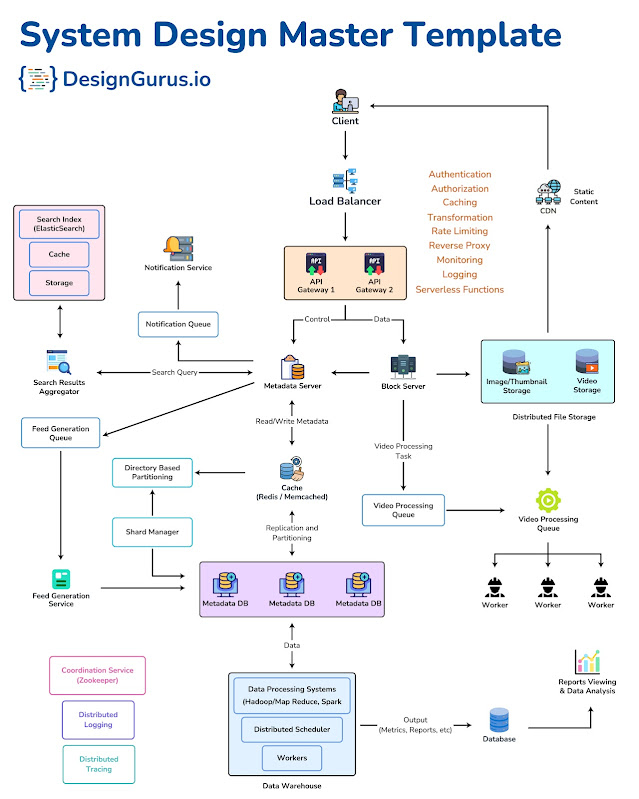Here is a master Design template:
1. 𝐋𝐨𝐚𝐝 𝐁𝐚𝐥𝐚𝐧𝐜𝐞𝐫: Distributes incoming network traffic across multiple servers to ensure no single server bears too much demand. This helps increase the availability and reliability of applications.
2. 𝐀𝐏𝐈 𝐆𝐚𝐭𝐞𝐰𝐚𝐲: Acts as a gatekeeper for APIs, handling request routing, composition, and protocol translation. Often includes functionalities like authentication, monitoring, and load balancing.
3. 𝐒𝐭𝐚𝐭𝐢𝐜 𝐂𝐨𝐧𝐭𝐞𝐧𝐭 & 𝐂𝐃𝐍: Delivery of static assets (like images and scripts) that don't change often, using a Content Delivery Network (CDN) to speed up their delivery by caching content in multiple locations around the world.
4. 𝐌𝐞𝐭𝐚𝐝𝐚𝐭𝐚 𝐒𝐞𝐫𝐯𝐞𝐫 𝐚𝐧𝐝 𝐁𝐥𝐨𝐜𝐤 𝐒𝐞𝐫𝐯𝐞𝐫: Components that manage metadata and data blocks, respectively. Metadata servers store information about where data blocks are located and their properties, while block servers actually store the data chunks.
5. 𝐃𝐢𝐬𝐭𝐫𝐢𝐛𝐮𝐭𝐞𝐝 𝐅𝐢𝐥𝐞 𝐒𝐭𝐨𝐫𝐚𝐠𝐞: Storage system designed to store data across multiple points of presence to increase data redundancy and reliability.
6. 𝐅𝐞𝐞𝐝 𝐆𝐞𝐧𝐞𝐫𝐚𝐭𝐢𝐨𝐧 𝐒𝐞𝐫𝐯𝐢𝐜𝐞 & 𝐐𝐮𝐞𝐮𝐞: Handles the processing and queuing of data needed to generate user-specific content feeds, like those seen on social media platforms.
7. 𝐒𝐡𝐚𝐫𝐝 𝐌𝐚𝐧𝐚𝐠𝐞𝐫 & 𝐃𝐢𝐫𝐞𝐜𝐭𝐨𝐫𝐲 𝐁𝐚𝐬𝐞𝐝 𝐏𝐚𝐫𝐭𝐢𝐭𝐢𝐨𝐧𝐢𝐧𝐠: Manages data sharding and partitioning strategies, optimizing data distribution and access by dividing larger databases into more manageable pieces.
8. 𝐍𝐨𝐭𝐢𝐟𝐢𝐜𝐚𝐭𝐢𝐨𝐧 𝐒𝐞𝐫𝐯𝐢𝐜𝐞 & 𝐐𝐮𝐞𝐮𝐞: Manages sending notifications to users, handling both the queueing of notification messages and their delivery.
9. 𝐂𝐚𝐜𝐡𝐞 (𝐑𝐞𝐝𝐢𝐬/𝐌𝐞𝐦𝐜𝐚𝐜𝐡𝐞𝐝): In-memory data storage used to reduce the number of times data is read from slower databases, enhancing performance by serving repeated requests for the same data quickly.
10. 𝐕𝐢𝐝𝐞𝐨 𝐏𝐫𝐨𝐜𝐞𝐬𝐬𝐢𝐧𝐠 𝐐𝐮𝐞𝐮𝐞 & 𝐖𝐨𝐫𝐤𝐞𝐫𝐬: Dedicated system components for video processing tasks, queuing them and distributing the workload among multiple workers to process the videos as needed.
11. 𝐃𝐢𝐬𝐭𝐫𝐢𝐛𝐮𝐭𝐞𝐝 𝐋𝐨𝐠𝐠𝐢𝐧𝐠 & 𝐓𝐫𝐚𝐜𝐢𝐧𝐠: Systems for logging and tracing the behavior of distributed systems, essential for debugging and monitoring the performance of distributed applications.
12. 𝐃𝐚𝐭𝐚 𝐏𝐫𝐨𝐜𝐞𝐬𝐬𝐢𝐧𝐠 𝐒𝐲𝐬𝐭𝐞𝐦𝐬 (𝐇𝐚𝐝𝐨𝐨𝐩/𝐌𝐚𝐩𝐑𝐞𝐝𝐮𝐜𝐞, 𝐒𝐩𝐚𝐫𝐤): Frameworks used for processing large data sets with a distributed algorithm on a cluster.


No comments:
Post a Comment